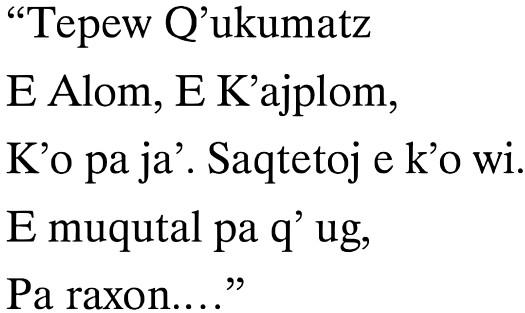Twilight of the Gods: The Mayan Calendar and the Return of the Extraterrestrials (15 page)
Read Twilight of the Gods: The Mayan Calendar and the Return of the Extraterrestrials Online
Authors: Erich Von Daniken

Excuse me? Two skulls? Let's return to our old friend Eusebius: "Many other strange creatures, each of which had a different appearance... one body but two heads."22
What seems so absurd-and made no sense at all to the Egyptologists, who knew that mummies were never destroyed because that would ruin any chance of reincarnation-seems to make sense from a contemporary perspective.
The gods had moved on, but they had left some of their chimeras behind. If these creatures were reborn, would they not continue to spread fear and consternation among the people of the future? This problem occupied the minds of the ancient priests-until suddenly they saw a way out of the mess. As long as the beasts remained alive, they were treated with awe and respect, prayed to and treated as divine. After their natural deaths, on the other hand, the bones of these unearthly creatures were smashed into tiny pieces and covered in tar. Sarcophagi were made of the hardest granite-so weighty and strong that no reborn monster could ever break its way out of the tomb. The mighty sarcophagi were not there to serve the process of reincarnationrather the opposite: They were prisons for eternity.
Is it possible to prove this?
Just a few bones with intact DNA would be enough and our clever geneticists would soon be able to say if they were looking at DNA that has arisen through natural evolution or whether it was a targeted artificial mutation. Nowadays, any interference in the genome can be verified. Maybe analyses such as these have already taken place and have been classified as top secret. The god shock would just be too much for mankind to cope with. Because evidence of chimeras in the dim and distant past would be indisputable evidence of alien intervention. Why?
Because our forefathers all those thousands of years ago didn't have a clue about genetics. Because the ancient texts and the illustrations tell us so. And because the ETs had a compelling motive for doing it: the creation of specially adapted life forms for other planets.
I call it memories of the future.



"There are no absolute truths, and if there were, they would be boring."
-Theodor Fontane, 1819-1898
This sentence cannot really be applied to the exact sciences. Two plus two always makes four. And in geometry, A squared plus B squared always equals C squared. It may be boring, but "exact science" does indeed bring us many "absolute truths." Alongside all the many errors that are constantly being corrected.
However, our power of reason is not just impressed by the results gleaned by the exact sciences; the humanities-and these include so much that requires interpretation-violate our way of thinking no less. Religions fall into this category, as do philosophy, ethnology, and archaeology. Excuse me? Isn't archaeology a combined science that cites only verified findings?
Of course. But the findings still have to be interpreted. They are still the subject of interpretation. This interpretation, on other hand, relies on rationality-the zeitgeist-and, of course, on written historical evidence. Is that clear? Now here's a short extract from Popol Vuh, the greatest writing from the legacy of the K'iche' Maya.' It was composed or written an unknown amount of time ago in the highlands of what is now Guatemala.

It might sound like Chinese to us, but to an expert it makes perfect sense. The text describes how the lord "Quetzal serpent" fathered children, descended from the heavens surrounded by light and covered in the feathers of the quetzal bird (hence the name). The quetzal serpent is said to have come from the blackness of the heavens, and so on. On the rear side of the folio 24 you can read how the gods first had to enter a "house of darkness" and needed torches. Consequently, they smoked cigars. (The god "Smoking Mirror" is depicted in numerous Maya temples.)

The "smoking gods" in the Madrid Codex. Author's own images.
I admire the Maya specialists who can read and translate the ancient language of the K'iche' Maya. Their skill is the result of the decades of hard work and the laborious efforts of the ethnologists who put together all the little pieces of the jigsaw. At the end of the day, though, these praiseworthy translations still remain subject to a great degree of interpretation in many respects. What do I mean? Interpretation is all down to the zeitgeist, the leading trend in "rational" thinking. And that is very flexible.
A "feathered snake" never existed. So in Guatemala, the quetzal bird seems a logical choice. It has an impressive plumage and may have even reminded the K'iche' Maya of a flying serpent. But the quetzal bird does not engender human children. Nor does it smoke! The Maya god "Smoking Mirror" also doesn't look anything like a quetzal bird in any shape or form.
A modern interpretation leaves room for a number of different possibilities, especially when contemporary viewpoints are brought together with other texts from other parts of the world. Impossible? Well, for the Maya specialists, just like the Egyptologists, text comparisons between Central America and Egypt are pretty much unthinkable. We're talking about two completely different cultures, they argue. That's right. So why is it, then, that when you start comparing the texts you keep finding all sorts of similarities? The "creation" in Popol Vuh is very similar to that in the first Book of Moses (Genesis). And there's more: If you read the Bible, you will discover that once the whole world "was of one language" (before the building of the Tower of Babel, that is). And it's no different in Popol Vuh. In the second book of Moses (Exodus) we find out how Moses held his staff out over the waters and divided them. The Maya tell the same story! Or in chapter 9, verse 17 of Genesis: "This is the token of the covenant, which I have established between me and all flesh that is on the earth...." And in Popol Vuh? "That will help you when you call me. It is the sign of our agreement...." And so on! Who was copying from whom? The authors of Popol Vuh couldn't have known anything about that Bible because their texts existed a long time before the Christian Spaniards arrived. So we can be pretty sure that there was no copying involved. These texts came about around the same campfire, so to speak.
Nowadays, in our times of worldwide networking and almost unlimited globalization, you would have thought that comparing texts would be the order of the day. But neither side wants to hear anything of it. The Maya archaeologist is a specialist in his own area; the Egyptologist in his. Without exception, a bunch of well-educated, well-integrated, and respectable researchers. The only problem is: they don't work together. Each group remains staunchily anchored by his own island of specialist isolation. Contemporary?
 iyramid Texts
iyramid Texts
In distant Egypt you will find the pyramid texts. What are they? They are engravings from the 5th and 6th dynasties-although it remains unclear how long the texts existed before they were chiseled into the granite. The pyramid texts are subdivided into "Utterances." These Utterances are overflowing with gods, who descend from the heavens to Earth, and pharaohs, who were granted the honor of visiting the world of the gods. Because our confused zeitgeist doesn't recognize any reality behind these stories, they are interpreted as being the wishful thinking of the priests or the journeys of the pharaohs after their deaths. Here are a few examples:'
